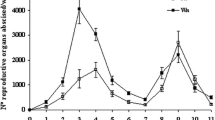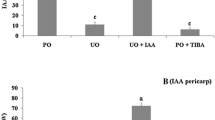Abstract.
Gibberellins A1 and A3 are the major physiologically active gibberellins (GAs) present in young fruit of pea (Pisum sativum L.). The relative importance of these GAs in controlling fruit growth and their biosynthetic origins were investigated in cv. Alaska. In addition, the non-13-hydroxylated active GAs, GA4 and GA7, were identified for the first time in young seeds harvested 4 d after anthesis, although they are minor components and are not expected to play major physiological roles. The GA1 content is maximal in seeds and pods at 6 d after anthesis, the time of highest growth-rate of the pod (Garcia-Martinez et al. 1991, Planta 184: 53–60), whereas gibberellic acid (GA3), which is present at high levels in seeds 4–8 d after anthesis, has very low abundance in pods. Gibberellins A19, A20 and A29 are most concentrated in seeds at, or shortly after, anthesis and their abundance declines rapidly with development, concomitant with the sharp increase in GA1 and GA3 content. Application of GA1 or GA3 to the leaf subtending an emasculated flower stimulated parthenocarpic fruit development. Measurement of the GA content of the pods at 4 d after anthesis indicated that only 0.002–0.5% of the applied GA was transported to the fruit, depending on dose. There was a linear relationship between GA1 content and pod weight up to about 2 ng · (g FW)−1, whereas no such correlation existed for GA3 content. The concentration of endogenous GA1 in pods from pollinated ovaries is just sufficient to give the maximum growth response. It is concluded that GA1, but not GA3, controls pod growth in pea; GA3 may be involved in early seed development. The distribution of GAs within the seeds at 4 d post anthesis was also investigated. Most of the GA1, GA8, GA19, GA20 and GA29 was present in the testa, whereas GA3 was distributed equally between testa and endosperm and GA4 was localised mainly in the endosperm. Of the GAs analysed, only GA3 and GA20 were detected in the embryo. Metabolism experiments with intact tissues and cell-free fractions indicated compartmentation of GA biosynthesis within the seed. Using 14C-labelled GA12, GA9, 2,3-didehydroGA9 and GA20 as substrates, the testa was shown to contain 13-hydroxylase and 20-oxidase activities, the endosperm, 3β-hydroxylase and 20-oxidase activities. Both tissues also produced 16,17-dihydrodiols. However, GA1 and GA3 were not obtained as products and it is unlikely that they are formed via the early 13-hydroxylation pathway. [14C]gibberellin A12, applied to the inside surface of pods in situ, was metabolised to GA19, GA20, GA29, GA29-catabolite, GA81 and GA97, but GA1 was not detected. Gibberellin A20 was metabolised by this tissue to GA29 and GA29-catabolite.
Similar content being viewed by others
Author information
Authors and Affiliations
Additional information
Received: 23 July 1996 / Accepted: 2 September 1996
Rights and permissions
About this article
Cite this article
Rodrigo, M., García-Martínez, J., Santes, C. et al. The role of gibberellins A1 and A3 in fruit growth of Pisum sativum L. and the identification of gibberellins A4 and A7 in young seeds. Planta 201, 446–455 (1997). https://doi.org/10.1007/s004250050088
Issue Date:
DOI: https://doi.org/10.1007/s004250050088




